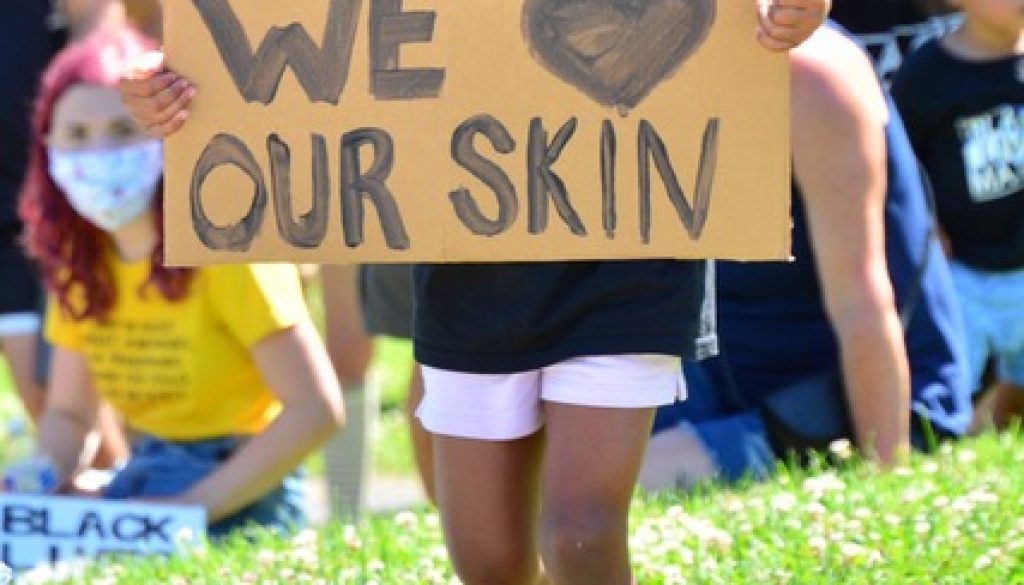A white parent advocates for racial equity
Tara Tinnin, is a parent with three daughters, ages 14, 11, and nine, in the Lindbergh School District. She and her husband moved to south St. Louis County about seven years ago largely to access a quality education for their kids. Tinnin is a social worker and attuned to issues concerning racial disparities. Increasingly, Tinnin became concerned about racial equity issues in the Lindbergh District and got together with other parents to form LEAD (Lindbergh Equity and Diversity), which has more than 600 followers on Facebook.. Here is an edited transcript of her interview with Richard Weiss.
Weiss: How did you get started with your activism around social justice and with LEAD in particular?
Tinnin: Personally, I got started much like other white members of our group where I made the choice, my husband and I made the choice, to move my family to the county from the city due to concerns about some issues with the city schools. We were having trouble, my oldest daughter needed an IEP and we tried to get her one for two years and it just wasn’t panning out. We just had really strong concerns that she would be able to be successful in the St Louis City Public School District, and we weren’t willing to do the private school route. So we set out on a search to find a new community, and weren’t really looking for anywhere specific outside of we wanted it to be central, and a house came available in the Lindbergh district, and we could afford it, and we had heard about the good schools. I was concerned about the lack of diversity, but like many other white parents, we still chose what we thought was, at the time, educational opportunity over that.
So we landed here, and I already had this, as a social worker, a social justice background, and understood what we were doing in some way, by moving our kids to a mostly white district. And had I just started to think about what that might mean for me and my family, and what our district might look like, and then the Stockley verdict happened. And I reached out to our principal to ask how they would be talking about it at school, and she informed me that they wouldn’t be.
And so all three of my kids were at the same school at that time. What was interesting was right around that time, several other parents had reached out to their principals in different schools asking the same questions. And then also one parent had a concern about a racist incident that happened to her child on the school bus. And so the principals had been talking and they said, “Why don’t we get you guys all together for a meeting? We do care about this. We just don’t know exactly what to do about it and what that would look like”
Tinnin: So when we got together for that first meeting, some of the other original members of LEAD were there. And the principals of the schools who had been involved were there, and some administrators were there. And it was interesting because the parents were trying to get a lay of the land with what was going on in the schools, and the administrators and principals are trying to feel us out like, “What do you want? You just tell us your concerns.” And some of the principals were more really action-oriented than others, but we really pretty quickly realized we needed to organize as a group if we were going to keep this at the forefront of their minds and press them to make social justice and anti-racism a priority in the district. It can be, as I’m sure you have come to find in your work, it is sometimes difficult to make really well meaning, kind, loving white folks understand why anti-racism is important in a mostly white community. What difference can that make really?
Weiss: This initial group of parents who were beginning to meet with administrators, I’m sensing that there were at least a few African American parents. What was the makeup of the group?
Tinnin: So initially at the first meeting, the very first meeting at the school, it was all white parents. There was one parent of an African American or biracial child. We recognized that as okay. There was always this tension of, we don’t want to center whiteness in this, but at the same time, it’s a lot white work that needs to be done. So how do we walk that line? And so we certainly had black members of our group throughout the years. Some have kind of come and gone, but that initial group of five or six women were all white. There are about 15 of us now.
Weiss: So you guys crafted this letter, with, I’m looking at this. Nine steps, recommendations, and I assume that came out of this core group.Were you guys getting any kind of pushback from some more or conservative parents saying, “Why are you raising all this racial stuff? We don’t see color and let’s just not go there.:
Tinnin: We haven’t got push back. I have heard comments like, “My kids don’t see color,” but not as a way to push back more as a way for people to provide us with their perspectives.” So I’ve heard that for sure. Now I can’t speak for all of our members and I don’t want to speak for any Black or Brown person in our community, but we do know of lots of racism and racist comments. So it exists. Right. It’s just people aren’t saying it to our faces.




